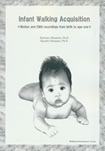Infant Walking Acquisition
- Motion and EMG recordings from birth to age one -
Paperback: 310pages
Language: English, Price: ¥9,500
ISBN: 978-4-902473-21-6 (2016)
【 Contents 】
Motion and EMG Recordings
CHAPTER 1 0~1 month
CHAPTER 2 1~2 months
CHAPTER 3 2~3 months
CHAPTER 4 3~4 months
CHAPTER 5 4~5 months
CHAPTER 6 5~6 months
CHAPTER 7 6~7 months
CHAPTER 8 7~8 months
CHAPTER 9 8~9 months
CHAPTER 10 9~10 months
CHAPTER 11 10~11 months
CHAPTER 12 11~12 months
Appendix
EMG characteristics of the walking development process
Walking development process and regression process
The acquisition of the upright posture and the first walking steps are emotional milestones in an infant's locomotor development. Scientists have been fascinated with the unstable, bipedal gait of initial walking since the 1930s, when most relevant studies were initiated. I too have been captivated, exploring infant walking from the 1960s to the present.
This book features the motion and EMG recordings of infants the moment they successfully performed their ''first locomotion after birth.'' Furthermore, it aims to make novel EMG data recorded simultaneously with serial photographs of ''infant locomotor development'' available worldwide. The contents are presented as a compilation of longitudinal recordings from the neonatal period up to the first steps taken at one year of age.
It is our hope that these recordings of the ''first little step,'' that great milestone for all families that marks the launching point of their infant's locomotor development, will likewise mark the launch and continued radiant progress of this field of study into the next generation of research.
''Walking acquisition is both a milestone of early locomotor development and a launching point for subsequent locomotor development''
Okamoto & Okamoto 2016
Professor Emeritus of Kansai Medical University
Director of Walking Development Group
Tsutomu Okamoto, Ph.D.
Walking Development Group
G-804, Tenno2-6, Ibaraki-shi, Osaka 567-0876, JAPANTEL/FAX 072(631)1788
Development of Gait by Electromyography
- Application to Gait Analysis and Evaluation -
Hardcover: 144pages (Jan 15,2007)
Language: English, Price: ¥5,500
ISBN: 978-4-902473-05-6
【 Contents 】
Part I
Development of Gait -Birth to Age Eight-
- Newborn stepping in neonates and young infants.
- Independent walking in Infants.
- From newborn stepping to mature walking.
Part II
Application to Gait Analysis and Evaluation
- An index of gait instability.
- Application of supported walking in normal neonates and infants.
- Application of recovery of walking in an elderly man after stroke.
FROM JAPANESE FAMILY
We have gathered together in this book the results of our study and analysis of gait carried out over the last 40 years, in the hope that this rare elctromyographical data concerning gait development will contribute to the further development of this field.
Part I contains our analysis, based on movement and muscle activity, of the development and changes in gait from birth until the age of eight, that is from the stage of neonatal reflex stepping, thought to be the origin of bipedal upright walking in human beings, through that of the acquisition and mastering of infant independent walking to that of the acquisition of mature adult walking.
Part II introduces our application of this to the analysis and evaluation of gait. We have created ''An Index of Gait Instability'' based on the results of our analysis of the gait development of infant independent walking, which we apply to research into the nature of human stepping and the evaluation of the level of restoration of walking functions in the elderly.
This study of gait carried out by one Japanese family may seem a very small step in the eyes of the world, but I firmly believe that our study will contribute the development of gait studies in the next generation.
We hope that this book will prove useful to those engages in gait studies, not only as a basic reference material analyzing the development of gait, but also as a basis for research, analysis and application in various fields that will help to generate new ideas about human gait.
Professor Emeritus of Kansai Medical University
Director of Walking Development Group
Tsutomu Okamoto, Ph.D.


